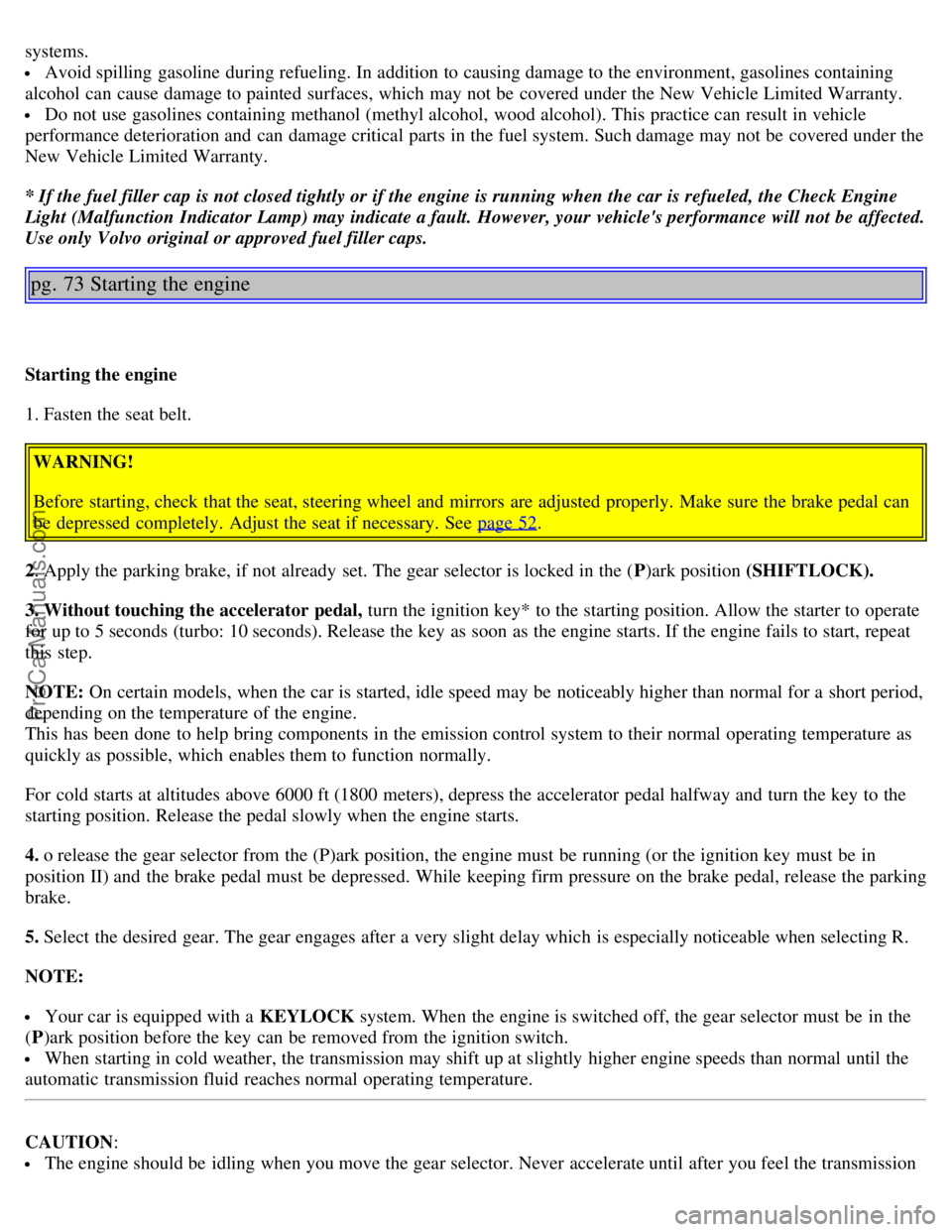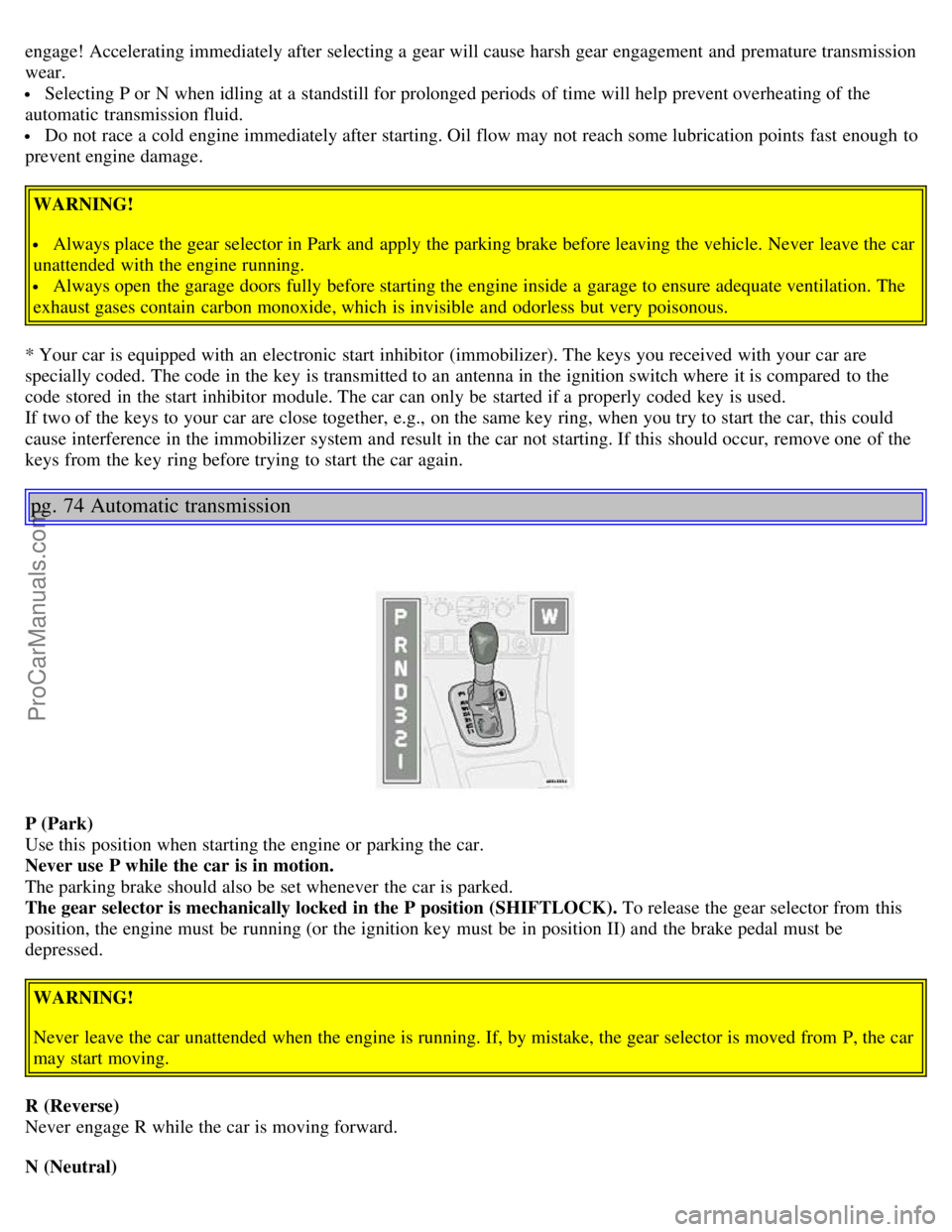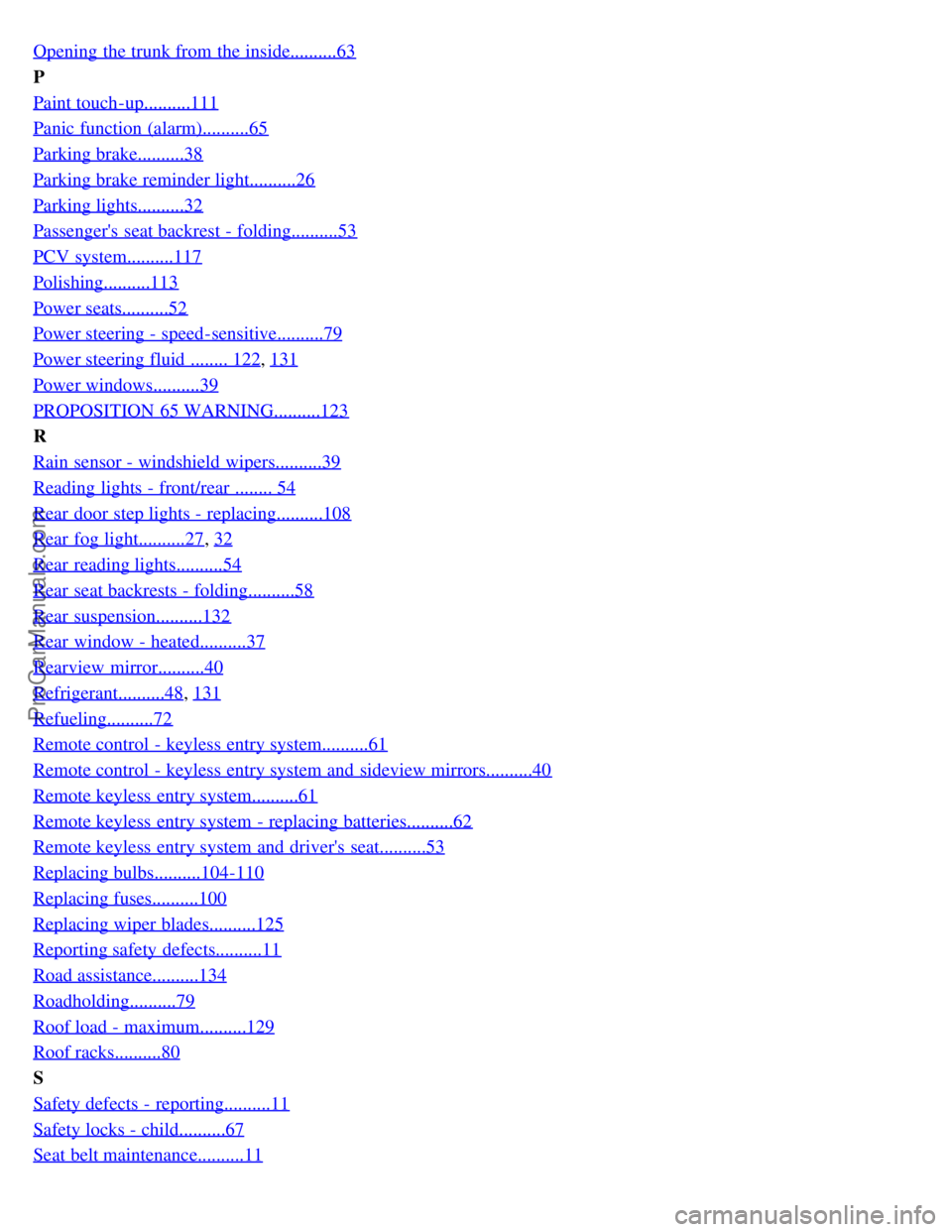2003 VOLVO S80 brake fluid
[x] Cancel search: brake fluidPage 3 of 109

12 mph (20 km/h). The brake pedal will pulsate several times and a sound may be audible from the ABS control
module. This is normal.
Fuel filler door
The fuel filler door, located on the right rear fender, is connected to your car's central locking system.
Press the button on the light switch panel (see page 32
) when the car is at a standstill to unlock the fuel filler door.
Please note that the fuel filler door will remain unlocked until the car begins to move forward.
An audible click will be heard when the fuel filler door relocks.
Fuel filler cap
After refueling, close the fuel filler cap by turning it clockwise until it clicks into place If this cap is not closed tightly
or if the engine is running when the car is refueled, the Malfunction Indicator Lamp ("Check Engine" light) may
indicate a fault.
Important
Before you operate your car for the first time, please familiarize yourself with the new-engine oil consumption
information on page 120
. You should also be familiar with the information in the chapters one, two and four of
this manual.
Information contained in the balance of the manual is extremely useful and should be read after operating the
vehicle for the first time.
The manual is structured so that it can be used for reference. For this reason, it should be kept in the car for
ready access.
Do not export your Volvo to another country before investigating that country's applicable safety and exhaust
emission requirements. In some cases it may be difficult or impossible to comply with these requirements.
Modifications to the emission control system(s) may render your Volvo not certifiable for legal operation in the
U.S., Canada and other countries.
All information, illustrations and specifications contained in this manual are based on the latest product
information available at the time of publication. Please note that some vehicles may be equipped differently,
depending on special legal requirements and that optional equipment described in this manual may not be
available in all markets.
Volvo reserves the right to make model changes at any time, or to change specifications or design, without
notice and without incurring obligation.
CALIFORNIA Proposition 65 Warning
WARNING! Engine exhaust, some of its constituents, and certain vehicle components contain or emit chemicals
known to the state of California to cause cancer, and birth defects or other reproductive harm. In addition, certain
fluids contained in vehicles and certain products of component wear contain or emit chemicals known to the State
of California to cause cancer, and birth defects or other reproductive harm.
Volvo and the environment
Volvo is committed to the well being of our customers. As a natural part of this commitment, we care about the
environment in which we all live. Caring for the environment means an everyday involvement in reducing our
environmental impact.
Volvo's environmental activities are based on a holistic view, which means we consider the overall environmental
ProCarManuals.com
Page 21 of 109

13 Fuel gauge
The fuel tank holds approximately 21.1 US gal. (80 liters).
When the warning light comes on there is approximately 1.8 US gal. (8 liters) of fuel remaining.
14 Indicator and warning lights
pg. 26 Indicator and warning lights
The indicator and warning lights described on pages 26 and 27 should never stay on when driving*
When the ignition key is turned, all of the warning lights in the lower right-hand side of the instrument panel should
go on to test the function of the bulbs. If a light does not go off after the engine has started, the system indicated
should be inspected.
NOTE: The parking brake reminder light will not go off until the parking brake has been fully released.
Warning lamp in the center of the instrument panel
This lamp lights up red or yellow depending on the severity of the fault that has been detected.
Yellow light: Follow the instructions shown in the text window.
Red light: Stop the car as soon as possible in a suitable location and read the message shown in the text window.
Supplemental Restraint System (SRS)
If the light comes on (or stays on after the vehicle has started), the SRS diagnostic system has detected a fault. Drive to
an authorized Volvo retailer for an inspection of the system. See the SRS section for more information.
BRAKE
Brake failure warning light
If the light comes on while driving or braking, stop immediately, open the hood and check the brake fluid level
in the reservoir. See page 122
for reservoir position and instructions.
Canadian models are equipped with this warning light:
Park
Brake
ProCarManuals.com
Page 52 of 109

systems.
Avoid spilling gasoline during refueling. In addition to causing damage to the environment, gasolines containing
alcohol can cause damage to painted surfaces, which may not be covered under the New Vehicle Limited Warranty.
Do not use gasolines containing methanol (methyl alcohol, wood alcohol). This practice can result in vehicle
performance deterioration and can damage critical parts in the fuel system. Such damage may not be covered under the
New Vehicle Limited Warranty.
* If the fuel filler cap is not closed tightly or if the engine is running when the car is refueled, the Check Engine
Light (Malfunction Indicator Lamp) may indicate a fault. However, your vehicle's performance will not be affected.
Use only Volvo original or approved fuel filler caps.
pg. 73 Starting the engine
Starting the engine
1. Fasten the seat belt.
WARNING!
Before starting, check that the seat, steering wheel and mirrors are adjusted properly. Make sure the brake pedal can
be depressed completely. Adjust the seat if necessary. See page 52
.
2. Apply the parking brake, if not already set. The gear selector is locked in the (P)ark position (SHIFTLOCK).
3. Without touching the accelerator pedal, turn the ignition key* to the starting position. Allow the starter to operate
for up to 5 seconds (turbo: 10 seconds). Release the key as soon as the engine starts. If the engine fails to start, repeat
this step.
NOTE: On certain models, when the car is started, idle speed may be noticeably higher than normal for a short period,
depending on the temperature of the engine.
This has been done to help bring components in the emission control system to their normal operating temperature as
quickly as possible, which enables them to function normally.
For cold starts at altitudes above 6000 ft (1800 meters), depress the accelerator pedal halfway and turn the key to the
starting position. Release the pedal slowly when the engine starts.
4. o release the gear selector from the (P)ark position, the engine must be running (or the ignition key must be in
position II) and the brake pedal must be depressed. While keeping firm pressure on the brake pedal, release the parking
brake.
5. Select the desired gear. The gear engages after a very slight delay which is especially noticeable when selecting R.
NOTE:
Your car is equipped with a KEYLOCK system. When the engine is switched off, the gear selector must be in the
( P )ark position before the key can be removed from the ignition switch.
When starting in cold weather, the transmission may shift up at slightly higher engine speeds than normal until the
automatic transmission fluid reaches normal operating temperature.
CAUTION :
The engine should be idling when you move the gear selector. Never accelerate until after you feel the transmission
ProCarManuals.com
Page 53 of 109

engage! Accelerating immediately after selecting a gear will cause harsh gear engagement and premature transmission
wear.
Selecting P or N when idling at a standstill for prolonged periods of time will help prevent overheating of the
automatic transmission fluid.
Do not race a cold engine immediately after starting. Oil flow may not reach some lubrication points fast enough to
prevent engine damage.
WARNING!
Always place the gear selector in Park and apply the parking brake before leaving the vehicle. Never leave the car
unattended with the engine running.
Always open the garage doors fully before starting the engine inside a garage to ensure adequate ventilation. The
exhaust gases contain carbon monoxide, which is invisible and odorless but very poisonous.
* Your car is equipped with an electronic start inhibitor (immobilizer). The keys you received with your car are
specially coded. The code in the key is transmitted to an antenna in the ignition switch where it is compared to the
code stored in the start inhibitor module. The car can only be started if a properly coded key is used.
If two of the keys to your car are close together, e.g., on the same key ring, when you try to start the car, this could
cause interference in the immobilizer system and result in the car not starting. If this should occur, remove one of the
keys from the key ring before trying to start the car again.
pg. 74 Automatic transmission
P (Park)
Use this position when starting the engine or parking the car.
Never use P while the car is in motion.
The parking brake should also be set whenever the car is parked.
The gear selector is mechanically locked in the P position (SHIFTLOCK). To release the gear selector from this
position, the engine must be running (or the ignition key must be in position II) and the brake pedal must be
depressed.
WARNING!
Never leave the car unattended when the engine is running. If, by mistake, the gear selector is moved from P, the car
may start moving.
R (Reverse)
Never engage R while the car is moving forward.
N (Neutral)
ProCarManuals.com
Page 66 of 109

2 0 0 3
VOLVO S80
Chapter 8 - Maintenance/Servicing
pg. 99 Maintenance/Servicing
Fuses100
Replacing bulbs104
Paint touch up111
Washing the car112
Cleaning the upholstery113
Maintenance service, Warranty114
Fuel/emissions systems115
Drive belt, Air pump system, Coolant116
Emissions maintenance117
Opening the hood, Engine compartment119
Engine oil120
Power steering/Brake fluid reservoirs122
Battery maintenance123
Replacing wiper blades125
pg. 100 Fuses
ProCarManuals.com
Page 81 of 109

Output194 hp at 5200 rpm (144 KW/87 rps)
Max. torque207 ft. lbs. at 3900 rpm (280 Nm at 65 rps)
Number of cylinders 6
Bore 3.27" (83 mm)
Stroke 3.54" (90 mm)
Displacement 2.92 liters (115 cu. in)
Compression ratio 10.5:1
Number of valves 24
Transmission specifications Automatic transmission
Gear ratios:
Engine: B 6294 TB 6294 S
1st gear 2.92:13.28:1
2nd gear 1.57:11.76:1
3rd gear 1.00:11.12:1
4 th gear 0.70:10.79:1
Reverse 2.39:12.67:1
Final drive 3.29:13.69:1
All specifications are subject to change without prior notice.
pg. 131 Oil/fluid specifications and volumes
Engine oil
Meeting minimum ILSAC specification GF-2, including ACEA A1, API SJ, SJ/CF and SJ/Energy Conserving.
Extra oil additives must not be used.
Volume: (including filter):
Normally-aspirated 6-cylinder engine - 7.3 US qts (6.9 liters).
Turbo 6-cylinder engine - 7.3 US qts (6.9 liters).
Automatic transmission fluid
Geartronic: ATF Dexron® III.
Total Volume: 13.4 US qts (12.7 liters).
Cooling system
Type: Positive pressure, closed system. The thermostat begins to open at 194 °F (90 °C).
Coolant: Volvo original coolant/antifreeze.
Volume: Normally-aspirated 6-cylinder engine - 9.3 US qts (8.8 liters).
Turbo 6-cylinder engine - 10.1 US qts (9.6 liters).
Power steering fluid
ATF fluid.
Volume: 6 cyl engine - 0.95 US qt (0.9 liter).
Brake fluid
ProCarManuals.com
Page 99 of 109

Geartronic..........76, 77
Kickdown..........76
Specifications..........130
Automatic transmission - cold starts..........75
Auxiliary socket..........29, 38
B
Backrests, rear seat - folding..........58
Battery..........87, 133
Battery maintenance..........123 -124
Replacing the battery..........124
Ventilation hose..........124
Blinds - rear/side rear windows..........42
Booster cushion..........13, 15
Booster cushion - integrated..........13
Brake failure warning light ..........26
Brake fluid..........122, 131
Brake system..........16
Bulbs (list)..........133
Bulbs - replacing..........104-110
C
Capacities (oils and fluids)..........127
, 131
Cargo net in trunk..........57
Catalytic converters - three-way..........89
Center console - switches..........29
Center head restraint - rear seat..........3
Central locking buttons..........63
Chains - winter driving..........93
Changing wheels..........96, 97
Child booster cushion ......... 13, 15
Child Restraint Anchorages ........ 12
Child safety..........12 -15
Child safety locks - rear doors..........67
Climate controls..........45 - 49
Climate system - general information..........48
Clock..........25
Coat hanger..........53
Cold weather driving..........87
Combination filter..........45, 49
Coolant..........116, 131
Cooling system..........78, 131
Courtesy light..........54
Courtesy lights (front) - replacing..........110
Courtesy lights - exterior..........60
Cruise control..........31
ProCarManuals.com
Page 103 of 109

Opening the trunk from the inside..........63
P
Paint touch-up..........111
Panic function (alarm)..........65
Parking brake..........38
Parking brake reminder light..........26
Parking lights..........32
Passenger's seat backrest - folding..........53
PCV system..........117
Polishing..........113
Power seats..........52
Power steering - speed-sensitive..........79
Power steering fluid ........ 122, 131
Power windows..........39
PROPOSITION 65 WARNING..........123
R
Rain sensor - windshield wipers..........39
Reading lights - front/rear ........ 54
Rear door step lights - replacing..........108
Rear fog light..........27, 32
Rear reading lights..........54
Rear seat backrests - folding..........58
Rear suspension..........132
Rear window - heated..........37
Rearview mirror..........40
Refrigerant..........48, 131
Refueling..........72
Remote control - keyless entry system..........61
Remote control - keyless entry system and sideview mirrors..........40
Remote keyless entry system..........61
Remote keyless entry system - replacing batteries..........62
Remote keyless entry system and driver's seat..........53
Replacing bulbs..........104-110
Replacing fuses..........100
Replacing wiper blades..........125
Reporting safety defects..........11
Road assistance..........134
Roadholding..........79
Roof load - maximum..........129
Roof racks..........80
S
Safety defects - reporting..........11
Safety locks - child..........67
Seat belt maintenance..........11
ProCarManuals.com